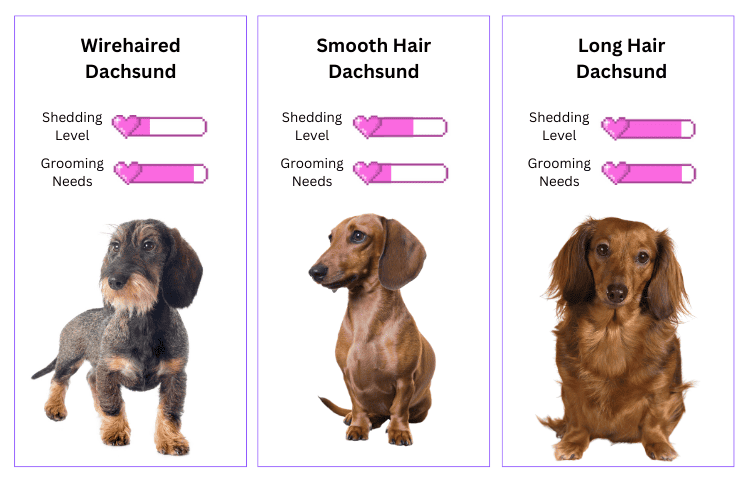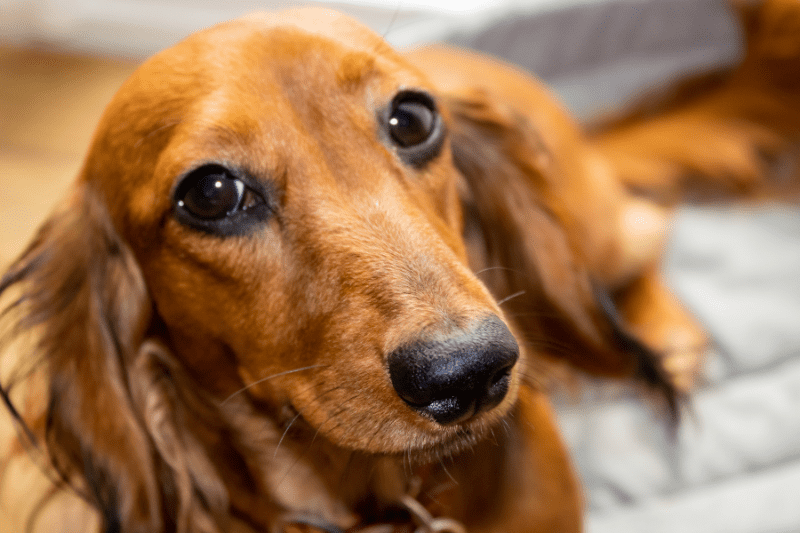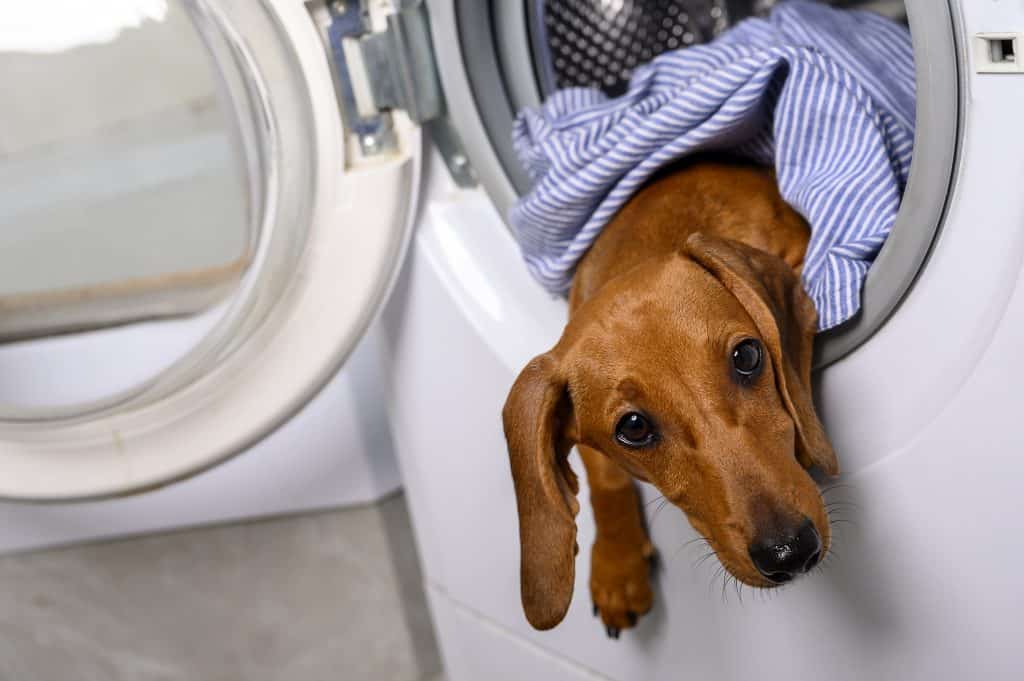
Do you ever feel like all the pet hair in your house is taking over? If you own a dachshund, shedding season can be overwhelming.
Dachshund shedding often appears to be never-ending, but with the right techniques and tools, you can keep it manageable.
Of course, as dachshund owners, we want to ensure our pups stay healthy and happy, so we must understand how to properly manage their shedding.
Keep reading to learn more about the shedding process, how to reduce it, and the best products to use.
Understanding Dachshund Shedding
Dachshunds come in a variety of coat types, including smooth, wirehaired, and longhaired, and have a range of colors and patterns.
Dachshunds, like all dogs, shed hair as part of their natural growth cycle. Understanding dachshund shedding can help you prepare for the amount of shedding you can expect and take steps to minimize it.
Additionally, understanding dachshund shedding patterns can help you determine the best grooming routine for your pet and choose the right products to help keep your home and furniture hair-free.
Knowing about dachshund shedding can also help you determine if a dachshund is a suitable breed for you, especially if you or someone in your household has allergies.
Do Dachshunds Shed a Lot?
Dachshunds are famously known to be moderate shedders. Throughout the year, they will drop some fur, with a slight spike during their two molting seasons where shedding may intensify.
Shedding is a natural process for all dogs and is a result of the hair growth cycle. As new hair grows in, the old hair falls out. This can result in loose hairs appearing on furniture, clothing, and other surfaces in your home.
Dachshunds, like many other dog breeds, shed seasonally. This shedding usually happens in the spring and fall months of each year- during the warmer seasons, their coats become lighter to accommodate for higher temperatures while they thicken up again when winter approaches. Shedding will be more noticeable at this time due to changes in your pup’s coat.
The amount of shedding can vary based on factors such as coat type, health, and lifestyle. Compared to other breeds, dachshunds are considered moderate shedders. However, the wire-haired variety tends to shed less than the smooth-coated and longhaired varieties.
Factors That Affect Dachshund Shedding
Several factors can affect the amount of shedding in dachshunds, including:
- Coat type: As mentioned, wire-haired dachshunds tend to shed less than smooth-coated and longhaired dachshunds.
- Health: Poor health, skin conditions, and hormonal imbalances can all lead to increased shedding in dachshunds.
- Seasonal changes: Just like people, dogs can experience seasonal changes that can increase shedding.
- Diet: A diet lacking essential nutrients can contribute to excessive shedding in dachshunds.
- Stress: Stressful events and changes in the environment can also result in increased shedding in dogs.
It’s important to keep in mind that every dachshund is unique, and the amount of shedding can vary greatly from one dog to another.
Related post: Do Dachshunds Shed a Lot?
Do Miniature Dachshunds Shed?
Miniature dachshunds shed the same amount as their larger counterparts, while the type of hair may have a minor alteration in shedding. Size is not an influential factor in determining how much your dachshund will lose fur!
When it comes to miniature dachshunds, the amount of shedding can vary based on age, health, and diet as well as coat type. But don’t despair! With proper grooming and care you’ll be able to manage the shedding rate so your pup is happy and healthy.
Regular brushing will help keep excess fur off furniture while providing additional bonding time with your pet. So make sure you’re prepared for some extra vacuuming or lint rolling; but in return, you’ll have an adorably fluffed doggo that everyone loves!
Related post: Do Miniature Dachshunds Shed?
Do long-haired dachshunds shed?
Longhaired dachshunds tend to lose the most fur of all three coat types, which demands more effort in terms of brushing and upkeep than the shorthair varieties do.
Even though longhaired dachshunds tend to shed more than the other types of dachshunds, regular brushing and bathing can keep their coat healthy with minimal shedding.
Caring for a longhaired dachshund includes providing them with proper nutrition loaded with essential vitamins and minerals, which can help to reduce the amount of shedding. Exercising your dog regularly is also an excellent way to promote better fur health and keep their coat looking healthy.
If you are considering a longhaired dachshund, know that it requires more grooming than other coat types; however, with the proper maintenance your pup can still have an enviable luxurious coat! When taken care of properly, your long-haired doxie will be looking its absolute best in no time.
Related post: Do long-haired dachshunds shed?

Which Type of Dachshund Sheds the Least?
When it comes to shedding, the wire-haired dachshund is usually the least shedding type. This breed’s coats are made up of thick guard hairs and an undercoat which helps keep dirt and debris at bay. As such, they experience minimal hair loss compared to smooth-haired or longhaired versions, which shed moderately and heavily respectively.
Dachshunds with wire hair are renowned for being the lowest shedding type of dachshund; however, they still require grooming to maintain healthy hair and skin. To keep their fur sleek and free of mats, a slicker brush and metal comb should be used regularly on Dachshunds with this type of coat.
Related post: Which type of dachshund sheds the least?
Do Dachshunds Shed Seasonally?
Absolutely, dachshunds are known for their seasonal shedding. Like many other dog breeds, this type of shedding typically occurs during spring and fall to accommodate the changing temperatures; when it’s warmer outside, their coats become thinner while they thicken up again in colder weather. As a result of these changes in fur thickness, you will likely notice more loss from your pup around this time than usual.
But how much and often they molt is also contingent upon various elements such as their age, health condition, and stress level. Therefore it’s imperative that you vigilantly monitor your dachshund’s shedding cycle and contact a veterinarian if any major variations arise.
Taking the time to understand seasonal shedding in dachshunds will help you create an effective plan for managing it. You may need to adjust your grooming habits and invest in some grooming tools, as well as make changes to your dog’s diet and lifestyle which can all play a role in decreasing shedding.
Furthermore, regular check-ups with a veterinarian are essential for making sure that no underlying health issues are causing increased shedding.
To keep your dachshund happy and healthy, it is important to comprehend and manage the natural seasonal shedding process. With proper care, you can ensure that your pup remains comfortable all year long.

Are Dachshunds Hypoallergenic?
Unfortunately, dachshunds are not suitable for those with severe allergies since they do shed moderately and produce allergens like dander.
Hypoallergenic dogs are those that produce fewer allergens such as dander, saliva, or fur shedding, making them the ideal companion for you if pet allergies run rampant in your household. Dog breeds, such as Poodle, Bichon Frise, or Maltese, are known for producing fewer allergens and shedding less.
However, if you have moderate allergies, with proper care and management, you may be able to enjoy the love and companionship of a dachshund. The best way to determine if a dachshund is suitable for you is to spend time with them and see how you react.
Related post: Are dachshunds hypoallergenic?
Are there nonshedding dachshunds?
No, there are no nonshedding dachshunds. Although wire-coated dachshunds shed less than other types of dachshunds, they shed just as well and produce dander and other allergens.
Some dachshund mixes may have hypoallergenic properties. So, if you’re looking for a dachshund with minimal shedding but don’t mind a mixed breed, research some of the available hypoallergenic dachshund mixes. These can include combinations of breeds like the Bichon Frise and Poodle.
Finally, remember that all dogs shed, and there is no such thing as a completely non-shedding dog.
Related post: Hypoallergenic Dachshund Mix

How do I stop my dachshund from shedding?
Maintaining your dachshund’s coat is essential to have a healthy and happy pup. A regular grooming routine that includes brushing their fur will help keep the shedding at bay while also promoting strong hair follicles.
Depending on the type of dachshund you have, specialized brushes may be necessary. For instance, short-haired coats should use slicker brushes whereas metal combs are best for wire-haired dogs.
Use of Tools and Products to Minimize Shedding
Ready to put an end to the relentless shedding from your dachshund? With these products, you can finally enjoy a clean home free of pesky fur!
- Shedding blades: These specialized brushes are designed to remove loose hair and undercoat.
- Deshedding shampoos: These shampoos contain ingredients that help loosen and remove dead hair from your dachshund’s coat.
- Anti-shedding supplements: These supplements contain vitamins and minerals that can help promote healthy hair growth and reduce shedding.
Click here to find the products you will need for grooming your dachshund
Changes to Diet and Lifestyle
To nourish your dachshund’s coat and skin, a balanced diet is critical. Additionally, incorporating dietary supplements and making lifestyle changes can be beneficial to their overall health as well.
- Providing a balanced diet: Feeding your dachshund a diet rich in essential nutrients can help promote healthy hair growth and reduce shedding.
- Reducing stress: Making sure your dachshund is in a relaxed and stress-free environment can help minimize shedding.
- Regular exercise: Regular exercise can help promote a healthy coat and reduce shedding.
Click here for our recommendation of the best dog food for dachshunds
It’s important to work with your veterinarian to determine the best approach to minimize shedding in your dachshund. They can help you create a personalized plan that takes into account your dachshund’s individual needs and health status.

Keeping the House Fur-Free
Regular grooming and providing proper nutrition to your dachshund will undoubtedly help keep shedding in check, but it won’t fully eliminate the problem. To make sure that pesky fur doesn’t take over your house, try these helpful tips:
- Vacuuming: Regular vacuuming can help remove pet hair from carpets, upholstery, and other surfaces.
- Lint Rollers and Brushes: Using lint rollers and pet hair removal brushes can help pick up hair from furniture and other surfaces.
- Furniture Covers: Using slipcovers or throws on furniture can help protect it from pet hair and make it easier to clean.
- Cleaning Routine: Incorporating a weekly deep cleaning routine that includes washing bedding, vacuuming and brushing pets, and sweeping or mopping floors can help keep pet hair under control.
- Containment: Designating a specific area for pets, such as a dog bed or kennel, can help reduce the amount of pet hair spread throughout the house.
By following these tips, you can help keep your home fur-free and minimize the amount of pet hair you have to clean up. It’s important to keep in mind that dachshunds do shed, but with the right tools and techniques, it’s possible to keep shedding under control and enjoy a clean and fur-free home.
How Do I Get Dog Hair Out Of My Clothes And Washing Machine?
If you’ve ever tried to get dog hair out of your clothes or washing machine, you know it can be difficult. Fortunately, there are some tips and tricks to make the process easier:
- Prevention is Key: Wearing lint rollers or keeping a lint roller nearby can help remove pet hair from clothing before it gets transferred to other surfaces.
- Washing Machine Maintenance: Regularly cleaning the lint trap in your washing machine and using a lint-catching laundry ball can help prevent hair buildup in your machine.
- Laundry Techniques: Washing pet hair-covered clothing inside out and using fabric softener can help loosen hair and make it easier to remove during the washing process.
- Special Products: There are special lint-removing products and brushes available that can help remove pet hair from clothing and washing machines.
By following these tips and techniques, you can help keep your clothes and washing machine free of pet hair, even if you have a dachshund that sheds a lot.
Related post: How Do I Get Dog Hair Out Of My Clothes And Washing Machine?
Final thoughts
In this article, we have covered the basics of dachshund shedding. We discussed how dachshunds shed as a natural process and compared their shedding to other breeds. We also covered how regular grooming and the use of shedding tools and products can help minimize shedding.
Additionally, we discussed the different types of dachshund coats and which ones tend to shed less, as well as the importance of understanding seasonal shedding patterns.
Dachshunds are a lovable and affectionate breed, but their shedding can be a challenge for some owners. By understanding more about dachshund shedding and taking steps to manage it, you can minimize the amount of hair your dachshund leaves around your home.
Regular grooming and the use of shedding tools and products can go a long way in helping to keep your dachshund’s shedding under control. Additionally, understanding the different coat types and seasonal shedding patterns can help you make informed decisions when choosing a dachshund.
With proper care, you can enjoy the love and companionship of a dachshund while keeping shedding to a minimum.
Recent Posts
Calculate the perfect food portions for your dachshund with our specialized calculator. Get customized feeding recommendations based on size, age, and activity level to support your wiener dog's back...
Looking for the perfect gift for a proud dachshund mom? We’ve rounded up the cutest dachshund shirts that celebrate your love for wiener dogs in style. Whether you’re shopping for yourself or a...


